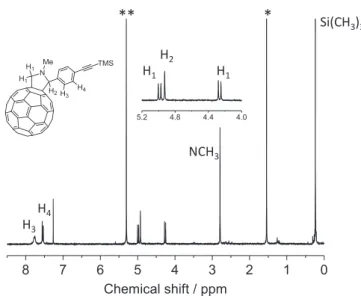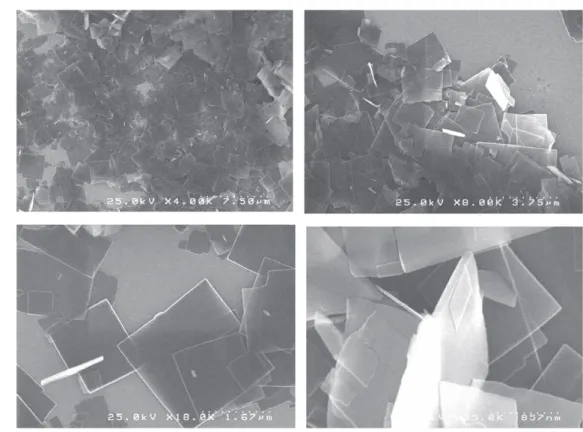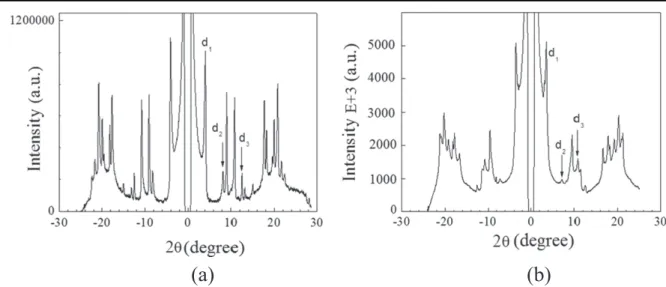HAL Id: hal-01156571
https://hal.archives-ouvertes.fr/hal-01156571
Submitted on 17 Nov 2015
HAL is a multi-disciplinary open access
archive for the deposit and dissemination of
sci-entific research documents, whether they are
pub-lished or not. The documents may come from
teaching and research institutions in France or
abroad, or from public or private research centers.
L’archive ouverte pluridisciplinaire HAL, est
destinée au dépôt et à la diffusion de documents
scientifiques de niveau recherche, publiés ou non,
émanant des établissements d’enseignement et de
recherche français ou étrangers, des laboratoires
publics ou privés.
Synthesis and self-assembly properties of
fulleropyrrolidine prepared by Prato reaction
Khanh Hy Le Ho, Stéphane Campidelli
To cite this version:
Khanh Hy Le Ho, Stéphane Campidelli. Synthesis and self-assembly properties of fulleropyrrolidine
prepared by Prato reaction. Advances in Natural Sciences : Nanoscience and Nanotechnology, IOP
Publishing, 2014, 5 (2), pp.025008. �hal-01156571�
This content has been downloaded from IOPscience. Please scroll down to see the full text.
Download details:
IP Address: 132.166.48.186
This content was downloaded on 13/06/2014 at 07:01
Please note that terms and conditions apply.
Synthesis and self-assembly properties of fulleropyrrolidine prepared by Prato reaction
View the table of contents for this issue, or go to the journal homepage for more 2014 Adv. Nat. Sci: Nanosci. Nanotechnol. 5 025008
(http://iopscience.iop.org/2043-6262/5/2/025008)
Synthesis and self-assembly properties of
fulleropyrrolidine prepared by Prato reaction
Khanh Hy Le Ho
1and Stéphane Campidelli
2 1Department of Biochemistry, Institute of Oceanography, Vietnam Academy of Science and Technology, 1 Cau Da, Nha Trang, Khanh Hoa, Vietnam
2
CEA Saclay, IRAMIS, NIMBE, Laboratory of Innovation in Surface Chemistry and Nanoscience (LICSEN), F-91191 Gif sur Yvette, France
E-mail:lehokhanhhy@gmail.com Received 13 March 2014
Accepted for publication 1 April 2014 Published 22 April 2014
Abstract
Molecular self-assembly is considered as a promising way to control the manufacture of new materials and their integration into hybrid devices with novel properties. In this work we have synthesized a fulleropyrrolidine bearing a phenylacetylene moiety via the Prato reaction. The characterization of the fulleropyrrolidine by nuclear magnetic resonance and optical
spectroscopy is reported, and its self-assembly by crystallization study has been investigated according to the used solvents. If the solvent that effectively solubilizes fullerene derivative is tetrahydrofurane, the nano-square plates with 1–3 μm in length and 50–100 nm in thickness are formed, while if the solvent is toluene, 5μm diameter ‘nano-flowers’ are obtained.
Keywords: fullerene, fulleropyrrolidine, self-assembly, nano-square plate, nano-flower Classification numbers: 4.00, 4.03
1. Introduction
During the last fifteen years, fullerene-based supramolecular assemblies have been extensively investigated. C60is a highly
hydrophobic molecule with a perfect icosahedral symmetry. It also possesses exceptional photophysical properties and low reorganization energy [1]. All these properties make fullerene an ideal candidate for a large number of applications such as solar cells [2, 3], organic light-emitting diode (OLED) [4], organic field-effect transistor (OFET) [5, 6]. The high performance of these optoelectronic devices is often condi-tioned by supramolecular organized structures of fullerene-based materials. So it is the key to mastering the aspects of supramolecular organization in organic optoelectronic devices.
The first example of fullerene-based supramolecular assemblies was the complexation of C60 with molecular
building blocks that favor the formation of inclusion com-plexes [7]. Later, by using classical covalent functionalization to make more sophisticated C60structures, the size, order, and
complexity of the supramolecular assemblies continuously
increased. This method has led to, for example, fullerene-based micelles, vesicles, and aggregates [8–18], polymers [19–25], and liquid crystals [26–35], as well as the organi-zation of fullerene on electrode or nanoparticle sur-faces [36–38].
In this paper we explore the self-assembling properties of a fulleropyrrolidine functionalized with a phenylacetylene moiety via the Prato reaction. The characterization of this compound by nuclear magnetic resonance (NMR), optical spectroscopy, x-ray diffraction as well as microscopy allowed identifying the interactions that lead to self-assembly properties.
2. Experimental
2.1. Material
C60 (99.9%) was purchased from MER Corporation.
Che-micals were purchased from Aldrich and were used as-received. Solvents were purchased form Aldrich or VWR and
2043-6262/14/025008+06$33.00 1 © 2014 Vietnam Academy of Science & Technology
| Vietnam Academy of Science and Technology Advances in Natural Sciences: Nanoscience and Nanotechnology
were used as-received. For synthesis, CH2Cl2 (CaH2, N2),
toluene (K/benzophenone, N2), tetrahydrofuran (THF) (K/
benzophenone, N2) were distilled before use.
2.2. Synthesis of fulleropyrrolidine
The Prato reaction [39] is an example of cycloaddition [3 + 2] from the azomethine ylides which are highly reactive 1,3 dipoles. The ylide is generated in situ after decarboxylation of iminium salts obtained by condensation of amino acids and aldehydes. These ylides react with the C60 to form
fulle-ropyrolidines. The synthesis of fulleropyrrolidine 2 is described in scheme1; it is obtained by condensation of 4-(2-trimethylsilylethynyl)benzaldehyde 1 [40] and N-methylgly-cine onto C60.
4-(2-trimethylsilylethynyl)benzaldehyde 1 was synthe-sized by Sonosashira coupling of 4-bromobenzaldehyde and trimethylsilylacetylene: To a stirred mixture of 4-bromo-benzaldehyde (9.25 g, 50.0 mmol), CuI (380 mg, 2.0 mmol), and Pd(PPh3)2Cl2(700 mg, 1.0 mmol) in 50 mL of THF was
added triethylamine (10.1 g, 75.0 mmol). A solution of tri-methylsilylacetylene (5.15 g, 52.5 mmol) in 10 mL of THF was then added over one hour. The solvent was evaporated, and the residue was treated with pentane. The filtration through Celite and evaporation of the solvent yielded com-pound 1.
Fulleropyrrolidine 2: C60 (50 mg, 0.069 mmol) was
dis-solved in dry toluene 50 mL and then 4-(2-trimethylsily-lethynyl)benzaldehyde (14 mg, 0.069 mmol) and N-methylglycine (62 mg, 0.693 mmol) were added. The mixture was stirred overnight at reflux, and then evaporated to dry-ness. The purification of the residue by column chromato-graphy (eluent toluene) and precipitation (dissolution in CH2Cl2and precipitation by pouring the solution into MeOH)
gave pure 2 as a brown powder.
2.3. Techniques
Absorption spectra were recorded in quartz cuvettes on a Perkin–Elmer Lambda 900 UV-Vis-NIR spectrophotometer.
1H NMR spectra were recorded with a Bruker ac-300 (300
MHz) spectrometer with solvent used as internal reference; MS (MALDI-TOF) spectra were recorded with a Persepti-veBiosystems Voyager DE-STR spectrometer. Scanning electron microscopy (SEM) measurements were performed using a Hitachi S4500 microscope. Molecular modeling was performed using the HyperChem software in conjunction with the MM+ method.
3. Results and discussion
3.1. UV-visible absorption spectra
The UV-visible absorption spectra of fulleropyrrolidine 2 in toluene shows two-band characteristics: a narrow and intense peak at 430 nm and a broad band around 700 nm, as shown in figure1. These peaks are characteristic of fulleropyrrolidine monoadducts [39].
3.2.1H NMR spectra
Due to the low solubility of compound 2 in CDCl3, the
signal-to-noise ratio of the NMR spectrum is not very good, but can be observed in the region between 4–5 ppm three protons belonging to the pyrrolidine (enlarged view of 1H NMR spectra shown in 4–5 ppm) (figure2). We note that the four aromatic protons resonate at 7.50 and 7.73 ppm. The signals of these protons should be doublets any time; because of the presence of the fullerene, they appear as a broad signal. The protons of NCH3resonate at 2.76 ppm and the protons of Si
(CH3)3at 0.2 ppm.
Adv. Nat. Sci.: Nanosci. Nanotechnol. 5 (2014) 025008 K H Le Ho and S Campidelli
2
3.3. Self-assembly and SEM photographs
We started by investigating the self-assembly properties of fulleropyrrolidine 2. The sample was dissolved in THF at a concentration of 1 mM, 500μl of this solution was filled into NMR tube and acetonitrile (AcCN) was slowly added to the top of the tube. This tube was capped and the solution was left two days to allow the slow diffusion of AcCN in THF. After two days at room temperature, the formation of precipitate is observed. The suspension was then homogenized and a drop was deposited on a silicon substrate to be imaged by SEM (scheme2). Figure 3shows a typical example of the images obtained: nano-square plates with 1–3 micrometers in length and 50–100 nm in thickness.
Nakanishi has extensively studied the different archi-tectural aspects of fullerene self-assembly as a function of the solvents. They showed that very simple molecules can give rise to a wide variety of assemblies according to the solvents used [12]. The difference of organization results from the balance between the‘good’ and ‘bad’ solvents for fullerene in the mixture. Therefore, we decided to explore the difference between two‘good’ solvents of the fulleropyrrolidine 2. We solubilized compound 2 in toluene and then AcCN was added. After seven days, the suspension was imaged by SEM, figure4 shows the type of assemblies obtained: ‘nano-flow-ers’ with about 5 microns in diameter. It is worth mentioning that toluene is a good solvent for both unfunctionalized fullerene and for compound 2 while THF is able to solubilize only the fulleropyrrolidine derivative. The different interac-tions of the toluene and THF with the fullerene part of 2 are certainly responsible for the difference of supramolecular organization.
3.4. X-ray diffraction and discussion on the formation of precipitate
To understand the organization of molecules in the nano-plates and in the nano-flowers, the precipitates were studied by x-ray diffraction. The diffraction pattern of 2 in the nano-plates (figure 5(a)) shows three reflections, d1= 21.675 Å;
d2= 10.77 Å and d3= 7.085 Å. These reflections, with a
spa-cing ratio 1:2:3, indicate a long-range lamellar organization of the C60 moieties with an average lamellar periodicity of
d = 21.5 Å. Other reflections, typically (hkl) with h, k or l indices simultaneously non-zero, reflect three-dimensional extension of the supramolecular nanostructure. In the same way, the diffraction pattern of the nano-flowers shows three reflections, d1= 24.4 Å, d2= 12.18 Å and d3= 8.16 Å
(figure 5(b)). These three reflections show once again the lamellar organization of the fulleropyrrolidine in the nanostructures.
By molecular modeling, we estimated that the length of a molecule of 2 is 17.7 Å (figure6(a)). The interlamellar dis-tance of about 21.5 Å and 24.4 Å in the nano-plates and the nano-flowers, respectively, do not correspond to either the length of a molecule or the length of an interdigitated bilayer of 2 (26.4 Å—figure 6(b)). It is therefore inferred that the molecules are inclined about 35° in the layers of the nano-plates and 22° within the layers of the nano-flowers (cosα = d/26,4) (figure6(c)).
‘Nano-flowers’ assemblies have been obtained by Nakanishi et al by slow cooling of a solution of full-eropyrrolidine containing long alkyl chains in 1,4-dioxane at 60 °C to 5 °C [41]. They explained the formation of these
Adv. Nat. Sci.: Nanosci. Nanotechnol. 5 (2014) 025008 K H Le Ho and S Campidelli
3
Figure 1.UV–visible spectra of fulleropyrrolidine 2 in toluene.
Figure 2.1H NMR Spectra of fulleropyrrolidine 2 in CDCl3(**
CDCl3, * H2O)1H NMR (300 MHz, CDCl3):δ = 7.72 (br, 2H; arom.
H), 7.51 (d, J = 8.7 Hz, 2H; arom. H), 4.94 (d, J = 9.3 Hz, 1H; H pyrrolidine), 4.89 (s, 1H; H pyrrolidine), 4.23 (d, J = 9.6 Hz, 1H; H pyrrolidine), 2.76 (s, 3H; NCH3), 0.20 ppm (s, 9H; SiMe3); FTIR
(KBr): ˜v = 2948, 2779, 2155, 1500, 1462, 1427, 1331, 1246, 1216, 1122, 1103, 864, 842, 758, 704, 582, 552, 526 cm−1; UV/Vis (toluene):λmax= 328, 432, 703 nm; MS (MALDI-TOF): m/z
calculated for C74H19NSi: 949.13 [M-H]+; found: 948.13.
objects by the successive folding of a very thin film of molecules.
4. Conclusion
We have described herein the synthesis and characterization of fulleropyrrolidine monoadduct bearing a phenyl-trimethylsilylacethylene moiety formed by Prato reaction. The
Adv. Nat. Sci.: Nanosci. Nanotechnol. 5 (2014) 025008 K H Le Ho and S Campidelli
4
Figure 3.SEM images of nano-plates obtained by self-assembly of fulleropyrrolidine 2 in the mixture of THF/AcCN.
self-assembly properties of the fulleropyrrolidine derivative have been investigated. The formation of the nano-plates and ‘nano-flowers’ seem more dependent on the interactions of the molecules with the solvent than the interactions between molecules themselves. Indeed, the organization is governed by the careful balance between‘good’ and ‘bad’ solvents for the fullerene derivatives.
Acknowledgment
This work has been partially supported by ANR (project f-DNA ANR-09-NANO-005-01). The authors warmly thank Benoit Heinrich and Dr Bertrand Donnio from the IPCMS in Strasbourg (France) for performing small-angle x-ray dif-fraction experiments.
Adv. Nat. Sci.: Nanosci. Nanotechnol. 5 (2014) 025008 K H Le Ho and S Campidelli
5
Figure 5.Small-angle x-ray diffractogram of the nano-plates (a) and the nano-flowers (b) formed by fulleropyrrolidine 2.
Figure 6.Estimated length of2 (a) and an interdigitated bilayer of 2 (b); representation of the organization of 2 in the bilayers of nano-plates (c).
References
[1] Guldi D M 2002 Chem. Soc. Rev.31 22
[2] Hoppe H and Sariciftci N S 2006 J. Mater. Chem.16 45 [3] Dang M T, Hirsch L, Wantz G and Wuest J D 2013 Chem. Rev.
113 3734
[4] Lee J Y and Kwon J H 2005 Appl. Phys. Lett.86 63514 [5] Haddock J N, Zhang X, Domercq B and Kippelen B 2005
Organics Electronics6 182
[6] Li H, Tee B C-K, Judy J C, Yi C, Jong W C, Sang Y L and Bao Z 2012 J. Am. Chem. Soc.134 2760
[7] Diederich F and Gmez-Lpez M 1999 Chem. Soc. Rev.28 263 [8] Burghardt S, Hirsch A, Schade B, Ludwig K and Bçttcher C
2005 Angew. Chem.117 3036
Burghardt S, Hirsch A, Schade B, Ludwig K and Bçttcher C 2005 Angew. Chem. Int. Ed.44 2976
[9] Zhou S, Burger C, Chu B, Sawamura M, Nagahama N, Toganoh M, Hackler U E, Isobe H and Nakamura E 2001 Science291 1944
[10] Nakashima N, Ishii T, Shirakusa M, Nakanishi T, Murakami H and Sagara T 2001 Chem. Eur. J.7 1766 [11] Nakanishi T, Schmitt W, Michinobu T, Kurth D G and Ariga K
2005 Chem. Commun.5982
[12] Nakanishi T 2010 Chem. Commun.46 3425
[13] Cassell A M, Asplund C L and Tour J M 1999 Angew. Chem. 111 2565
Cassell A M, Asplund C L and Tour J M 1999 Angew. Chem. Int. Ed.38 2403
[14] Georgakilas V, Pellarini F, Prato M, Guldi D M,
Melle-Franco M and Zerbetto F 2002 Proc. Natl. Acad. Sci. USA99 5075
[15] Hizume Y, Tashiro K, Charvet R, Yamamoto Y, Saeki A, Seki S and Aida T 2010 J. Am. Chem. Soc.132 6628 [16] Charvet R, Yamamoto Y, Sasaki T, Kim J, Kato K, Takata M,
Saeki A and Aida T 2012 J. Am. Chem. Soc.134 2524 [17] Babu S S, Moehwald H and Nakanishi T 2010 Chem. Soc. Rev.
39 4021
[18] Le Ho K H et al 2013 Chem. Eur. J.19 11374 [19] Giacalone F and Martín N 2006 Chem. Rev.106 5136 [20] Fernández G, Pérez E M, Sánchez L and Martín N 2008
Angew. Chem. Int. Ed.47 1094
[21] Fernández G, Pérez E M, Sánchez L and Martín N 2008 J. Am. Chem. Soc.130 2410
[22] Nishimura T, Tsuchiya K, Ohsawa S, Maeda K, Yashima E, Nakamura Y and Nishimura J 2004 J. Am. Chem. Soc.126 11711
[23] Haino T, Hirai E, Fujiwara Y and Kashihara K 2010 Angew. Chem.122 8071
Haino T, Hirai E, Fujiwara Y and Kashihara K 2010 Angew. Chem. Int. Ed.49 7899
[24] Wang C-L et al 2011 Adv. Mater.23 2951 [25] Wang C-L, Zhang W-B, Sun H-J, Van Horn R M,
Kulkarni R R, Tsai C-C, Hsu C-S, Lotz B, Gong X and Cheng S Z D 2012 Adv. Energy Mater.2 1375
[26] Deschenaux R, Donnio B and Guillon D 2007 New J. Chem. 31 1064
[27] Lenoble J, Campidelli S, Maringa N, Donnio B, Guillon D, Yevlampieva N and Deschenaux R 2007 J. Am. Chem. Soc. 129 9941
[28] Maringa N, Lenoble J, Donnio B, Guillon D and Deschenaux R 2008 J. Mater. Chem.18 1524 [29] Campidelli S, Bourgun P, Guintchin B, Furrer J, Stoeckli-Evans H, Saez I M, Goodby J W and Deschenaux R 2010 J. Am. Chem. Soc.132 3574 [30] Hoang T N Y, Pociecha D, Salamonczyk M, Gorecka E and
Deschenaux R 2011 Soft Matter7 4948 [31] Mamlouk H, Heinrich B, Bourgogne C, Donnio B,
Guillon D and Felder-Flesch D 2007 J. Mater. Chem. 17 2199
[32] Vergara J, Barberá J, Serrano J L, Ros M B, Sebastián N, de La Fuente R, López D O, Fernández G, Sánchez L and Martín N 2011 Angew. Chem.123 12731
Vergara J, Barberá J, Serrano J L, Ros M B, Sebastián N, de La Fuente R, López D O, Fernández G, Sánchez L and Martín N 2011 Angew. Chem. Int. Ed.50 12523
[33] Sawamura M, Kawai K, Matsuo Y, Kanie K, Kato T and Nakamura E 2002 Nature419 702
[34] Matsuo Y, Muramatsu A, Hamasaki R, Mizoshita N, Kato T and Nakamura E 2004 J. Am. Chem. Soc.126 432 [35] Matsuo Y, Muramatsu A, Kamikawa Y, Kato T and
Nakamura E 2006 J. Am. Chem. Soc.128 9586 [36] Imahori H 2007 Bull. Chem. Soc. Jpn.80 621 [37] Imahori H 2007 J. Mater. Chem.17 31
[38] Bonifazi D, Enger O and Diederich F 2007 Chem. Soc. Rev. 36 390
[39] Maggini M, Scorrano G and Prato M 1993 J. Am. Chem. Soc. 115 9798
Prato M and Maggini M 1998 Acc. Chem. Res.31 519 [40] Thorand S and Krause N 1998 J. Org. Chem.63 8551 [41] Nakanishi T, Ariga K, Michinobu T, Yoshida K, Takahashi H,
Teranishi T, Mçhwald H and Kurth D G 2007 Small3 2019
Adv. Nat. Sci.: Nanosci. Nanotechnol. 5 (2014) 025008 K H Le Ho and S Campidelli


